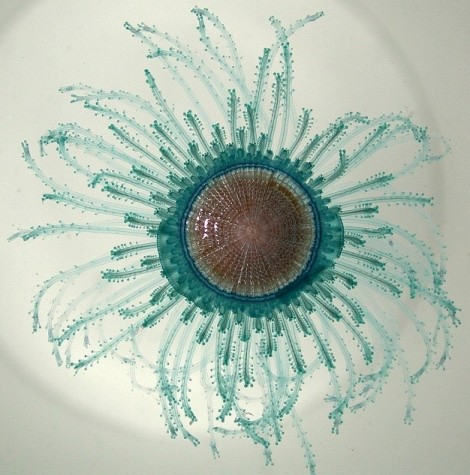Hydrozoans often form colonies that are dimorphic or polymorphic (Pechinik 2010). To understand polymorphism, imagine that you live in a town where your neighbor, your grocer, and your policeman are all genetic clones of yourself. In fact, everybody in the town is the same person, just performing different functions. Then, instead of a town you are actually part of a fearsome Portuguese man-of-war and instead of being a policeman you are a dactylzooid heavily armed with nematocysts. But first, let’s start from the top…
When people think of the Class Hydrozoa, they usually think of Hydra, the cnidarian that lacks a medusa phase in its life cycle. The lack of a medusoid form could be selected against in many instances but many hydrozoans actually have both the polyp and medusa form (Pechenik 2010).
What many people fail to notice is how diverse the hydrozoans actually are. For instance, the widely studied Hydra is a single organism that has different types of specialized cells for feeding, reproduction, and keeping the organism grounded. Many hydrozoans take this partitioning of specialized labor to a whole new level known as polymorphism. In colonial hydrozoans, individual organisms will form specialized structures that are part of a bigger colony. For instance, in Porpita the animal is actually made up of several zooids (BiologyToday).
Zooids are units that belong to a colony derived from a single planula larva (Pechenik 2010). A quick glance at Porpita and one might assume that it is a jellyfish, but it is actually a colony of specialized zooids, all with individual functions that benefit the colony as a whole (Kennedy). Porpita has gonozooids, which focus exclusively on reproduction, or the formation of medusoids. In many cases, gonozooids have lost the ability to feed and must be connected to the gastrovascular cavity. For feeding, gastrozooids have a mouth surrounded by specialized tentacles that are densely packed with nematocysts to catch small organisms for digestion. The digested food caught by the gastrozooids can then be redistributed across the colony. Along the rim of Porpita are several dactylzooids, which are essentially modules dedicated to the defense of the colony. Dactylzooids lack a mouth but are heavily armed with stinging nematocysts. Hydroid colonies that consist of two types of modules are dimorphic and those that consist of more than two types of modules are polymorphic (Pechenik 2010)
So back to the beginning: hydrozoan polymorphism is readily apparent in the order Siphonophora, and especially in the infamous and marvelous Portuguese man-of-war. Like Porpita the Portuguese man-of-war is actually a colony of organisms working together and being comprised of four different types of polyps (National Geographic).
In addition to the gonozooids, gastrozooids, and dactylzooids, the Portuguese Man-of-War also has a pneumatophore and a modified medusoid that forms a large sail. They contain glands that produce a mostly carbon monoxide gas that fill cavity (BiologyToday). The dactylzooids are mouthless individuals that possess spirals of deadly nematocysts. When unsuspecting fish get caught on these long tentacles, they coil up to bring the prey towards the gastrozooids which can then externally digest the food into a liquid that is divided among the colony.
References:
Kennedy, Jennifer (2014) “Blue Button Jelly (Porpita porpita).”Marine Life. About.com, n. d. Web. 26 Jan 2014. <http://marinelife.about.com/od/invertebrates/p/Blue-button-jelly-profile.htm>.
Pechenik, Jan A. (2012) Biology of the Invertebrates. Sixth. New York: McGraw-Hill, 110-115. Print.
Biology Today. (2014). Polymorphism in the Cnidarian order Hydrozoa.”Invertebrate Zoology. Biology-Today, n. d. Web. 27 Jan 2014. <http://biology-today.com/general-zoology/invertebrate-zoology/polymorphism-in-the-cnidarian-order-hydrozoa/>.
National Geographic (2014). “Portuguese Man-of-War.” National Geographic. n.d. n. page. Web. 27 Jan. 2014. <http://animals.nationalgeographic.com/animals/invertebrates/portuguese-man-of-war/>.


